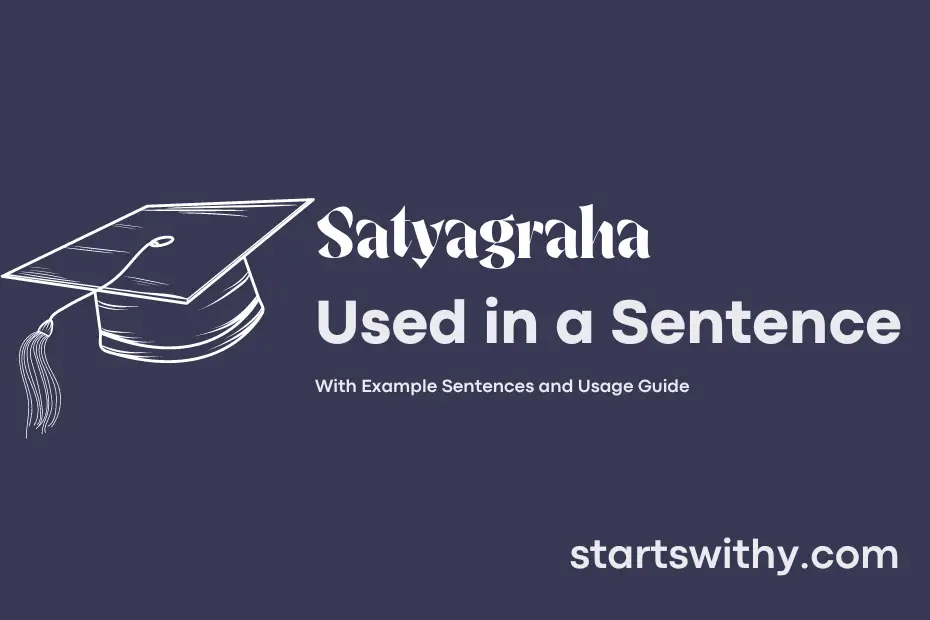Satyagraha, a term popularized by Mahatma Gandhi during India’s struggle for independence, embodies the principles of nonviolent resistance. Derived from Sanskrit words meaning “truth” and “insistence,” satyagraha encourages individuals to peacefully confront injustice through active, yet nonviolent, means.
This philosophy advocates for the use of civil disobedience, sit-ins, protests, and strikes as tools to bring about social and political change without resorting to violence. Satyagraha has been adopted as a powerful tool by many movements around the world seeking to challenge authority and address systemic issues through nonviolent methods.
7 Examples Of Satyagraha Used In a Sentence For Kids
- Satyagraha means fighting with love and truth.
- Mahatma Gandhi used satyagraha to achieve independence for India.
- We can solve problems peacefully with the help of satyagraha.
- Satyagraha teaches us to be brave and stand up for what is right.
- We should always remember the importance of satyagraha in our lives.
- Using satyagraha, we can make the world a better place.
- Let’s practice satyagraha every day by being kind and honest.
14 Sentences with Satyagraha Examples
- Satyagraha is a powerful tool that Mohandas Gandhi used during India’s freedom struggle.
- It is important for students to understand the concept of satyagraha in order to bring about positive change in society.
- College students can learn a lot about resilience and perseverance from the principles of satyagraha.
- Nonviolent protests are a key aspect of satyagraha and have been successful in many social movements.
- The spirit of satyagraha encourages individuals to stand up for truth and justice, even in the face of adversity.
- Many college students in India have been inspired by the principles of satyagraha to work towards social justice and equality.
- It is important for students to practice satyagraha in their everyday lives by standing up against injustice and discrimination.
- By implementing satyagraha, students can become agents of change in their communities and make a positive impact.
- The philosophy of satyagraha teaches students to protest peacefully and resolve conflicts through dialogue and understanding.
- College campuses can be breeding grounds for satyagraha movements that promote unity and solidarity among students.
- Students can use the principles of satyagraha to challenge oppressive systems and advocate for progressive change.
- By practicing satyagraha, students can create a more inclusive and equitable society for future generations.
- The legacy of satyagraha continues to inspire young people to fight for truth and justice in a nonviolent manner.
- As future leaders of the country, college students have a responsibility to uphold the values of satyagraha and work towards building a more just society.
How To Use Satyagraha in Sentences?
Satyagraha is a powerful concept originated by Indian leader Mahatma Gandhi, and it can be used in a sentence as a method of peaceful resistance. When using Satyagraha in a sentence, it is important to understand its meaning as “truth force” or “soul force“.
For beginners, start by incorporating the word Satyagraha in a sentence where you are emphasizing the use of nonviolent resistance towards a cause or issue. For example, “The activists used Satyagraha to protest against the unjust laws peacefully.”
When constructing a sentence with Satyagraha, consider its essence of standing up for what is right or just while remaining peaceful and nonviolent. This can be further illustrated in a sentence like, “Through Satyagraha, the community was able to bring about positive change without resorting to aggression.”
Remember, Satyagraha is a tool of protest that relies on the core principles of truth, nonviolence, and resistance. By using this term in a sentence, you are highlighting the importance of peaceful activism in bringing about social or political change.
In conclusion, incorporating Satyagraha in a sentence can help convey a message of peaceful protest and the power of standing up for what is right.
Conclusion
In conclusion, the concept of satyagraha, meaning “truth force” or “soul force,” refers to Mahatma Gandhi’s nonviolent resistance movement that advocated for civil disobedience and passive resistance to bring about social or political change. Examples of sentences with satyagraha illustrate its underlying principles of truth, nonviolence, and the belief in the power of moral force to overcome injustice. Gandhi’s use of satyagraha during India’s struggle for independence against British colonial rule serves as a prominent historical example of how peaceful resistance can lead to significant societal transformation.
Overall, sentences with satyagraha highlight the enduring legacy of this philosophy, emphasizing the importance of standing up for one’s beliefs through peaceful means, even in the face of oppression. By embodying the spirit of satyagraha, individuals can inspire positive change and promote justice, equality, and human rights through nonviolent activism and unwavering commitment to truth and righteousness.



